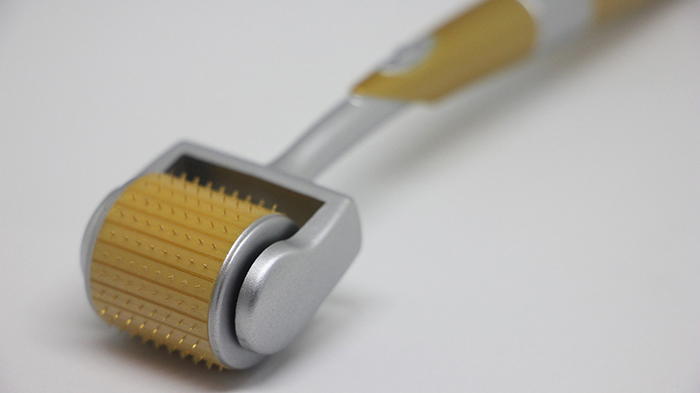
Clinical
Radiofrequency and Non-RF Microneedling Safety: What Patients Should Know
With Molly Muecke, RN, MSN, NP-CMicroneedling is a popular aesthetic treatment offered in 79% of med spas (2024 Medical Spa ...
Posted By Mike Meyer, Friday, July 31, 2020

By Misti Barnes, CEO, Cellustrious Hair Rejuvenation
It's no secret to those with medical and aesthetic practices that the industry is in for stormy weather when it comes to navigating business amidst COVID-19. The future will include more telemedicine and virtual consultations, as well as a highly cautious patient and clientele base. It means medical spas have to communicate a strong focus on sterility and safety. And pricing. And value. The solution, in some situations, will mean less-invasive options. In other situations, it means expanding your offerings.
When it comes to aesthetics, the future is about ease, effectiveness and providing value. This is especially true when it comes to hair rejuvenation procedures.
Fifty-six million Americans struggle with hair loss. As a professional trichologist, I see more and more young patients coming in for help with thinning and premature loss. Stress, diet, lifestyles, unbalanced hormones and medications have led to a younger demographic of men and women with hair loss.
When it comes to hair loss, the "go-to" options have been surgery (follicular unit extraction, follicular unit transplantation) and/or a combination of medications, such as finasteride (Propecia), minoxidil (Rogaine) and dutasteride.
Over the last five years, the use of platelet rich plasma (PRP)—which involves centrifuging the patient's own blood and injecting the platelets back into the scalp—has increased in popularity. One of the newest treatments utilizes exosomes (extra cellular vesicles), which is a process by which growth factors—generally derived from human mesenchymal stem cells—are injected into the scalp.
While surgical options work for some, a large population of patients want less invasive, drug-free options. And, for clinics that want to offer an option that is non-invasive, there is the option of microneedling combined with plant-derived peptides and growth factors. The beauty of this treatment is that it's relatively pain-free, requires no labs or blood draws, offers a high ROI, and, in many states, can be performed by aestheticians.
Let's begin by looking at the science behind microneedling. Microneedling was originally developed to rejuvenate the skin, improve abnormal pigmentation and reduce scarring, using an electrical oscillating device to create shallow perforations in the skin. The resulting localized "trauma" leads to skin improvement, due to the body's natural healing response. When we injure tissue, our bodies generate an acute inflammatory response that allows the body to repair that injury. If the injury is minor, like the inflammation from microneedling, our bodies can achieve perfect wound healing. Microneedling not only creates localized trauma, but also produces thousands of microchannels that greatly enhance the penetration of topically applied substances.
A 2013 study on androgenetic alopecia (AGA) confirmed the benefits on microneedling for hair regrowth on humans. In this study, all participants (using 1.5 mm needle) cited hair improvement of +2 and +3 grades on a seven-point scale in just six months.
In 2014, after training in collagen restoration with one of the developers of microneedling—who worked with burn survivors along with Dr. Richard Grossman, of the Grossman Burn Center—I began researching the connection between scalp fibrosis and hair loss.
I noticed there were things that drugs and surgery weren't addressing when it came to hair loss—scalp fibrosis and calcification, which I believe are key components in hair loss. Most hair restoration treatments (including PRP, surgery and exosomes) do not address or target these factors.
It's not just "all about the genes." Many people are diagnosed with adrogenetic alopecia (male- and female-pattern baldness) far too early. Hair loss is "polygenic," meaning it can come from either side of the gene pool, so more recent research shows that a person is likely to inherit similar hair loss tendencies to the family member whose hair characteristics their hair most resembles: color, type and distribution.
While our genes may predispose us to hair loss, epigenetics tells us we have some control over what genes are expressed through our behavior. If we don't trigger those genes or alter our behavior, we can have an impact on hair loss. Additionally, we can trigger some of the hair follicles that have gone into dormancy, whether due to dihydrotestosterone (DHT), fibrosis, inflammation or a host of other causes. And we're seeing new science that hints at hair loss is reversible.
Microneedling leads to "acute inflammation" and down-regulates calcification inducers—such as transforming growth factors—and upregulates calcification inhibitors, which promote scarless healing. This creates an ideal balance of calcification regulators. As seen by regrowth of hair and improvement in skin scars, if we "acutely" injure areas with calcification and fibrosis, the healing process erases most of the calcification and fibrosis.
"Acute wounding" promotes angiogenesis—the formation of new blood vessels—which provides oxygen and nutrients to the follicles. By re-establishing oxygen and increasing blood flow, we increase hair regrowth and thickening. Mechanical stimulation (microneedling) upregulates the genes that increase hair regrowth and downregulate the genes that increase hair loss. The acute, short-term trauma caused by microneedling improves localized blood flow, and allows for enhanced penetration of topical products applied to the scalp.
My research led to the development of the Hair Follicle Rejuvenation Protocol, where I began to combine microneedling with polypeptides. The results were promising, but they varied based upon the depth, timing and the consistency of the treatments. For the next two years, I worked on anecdotal trials with microneedling. I was then asked to participate in clinicals trial for a leading lab in Irvine, California, using microneedling with bone marrow stem cell cytokines. The results were fairly consistent, but I wanted a more stable, reliable protocol, so I began researching plant-derived biosignals and peptides.
I began moving away from human-derived stem cell cytokines to plant-derived biomimetic options. In addition to the high quality and safety with biosignals and peptides modified post-translationally, I found the plant-derived growth factors and peptides more stable when it came to hair loss.
I then partnered with a leading biochemist with a background in hair science (Aveda, L'Oreal) who holds 40 hair patents, and together we developed an in-office and home protocol called Cellustrious, which combines microneedling with nine of the most powerful plant-derived biosignals.
In client experience trials of Cellustrious on a sample size of 50 people, the results were highly successful, with all experiencing between 30% – 40% increase in growth. Before-and-after pictures consistently demonstrate growth ranging from significant to dramatic among men and women. Many of the pictures show significant improvement after even two treatments.
Protein molecules naturally stimulate cellular growth and function. They also regulate cell division and cell survival by binding to receptors on the cell's surface that activate cellular proliferation. These rejuvenating properties support a natural and safe process that aids in the improvement and appearance of thinning, balding, aging hair.
These plant-derived peptides have been scientifically formulated with the necessary proteins and antioxidants that aid in the maintenance needed for a healthy hair follicle structure. More growth factors give the appearance of more vibrant, fuller, thicker and youthful looking hair.
Hair loss is complex. I tell all my patients that hair loss is the symptom, not the diagnosis. The body is sending a red flag that something is wrong internally.
While DHT is often pointed to as the culprit for hair loss, it occurs when the androgen testosterone attaches to the 5-alpha enzyme and converts it to DHT. Over time, this causes the follicle to miniaturize and go into a dormant state.
The causes are a myriad, from free radicals and toxicity to a lack of circulation in the follicle base and bodily inflammation. They are not always easy to identify.
Ultimately, I believe that we can reverse hair loss in many situations, but it takes a comprehensive approach. In addition to targeting the symptoms loss, patients need to address lifestyle (stress, medications and hormones), the microbiome and our diet. And, speaking of diet, I've found that home maintenance a key component to success when it comes to hair restoration. It might not be as easy as popping a pill, but the more a patient contributes to their own healing and health, the better the outcome.
With health and safety being top of mind, offering a non-invasive option that doesn't require blood draws, labs or the concern of cross contamination is an attractive option. Additionally, the plant-derived option appeals to the "green" consumer with a socially conscious viewpoint.
Most importantly, the results are there. Clinical trials bear out the fact the plant-derived peptides are effective, adaptable and non-toxic.
With an easy-to-assemble, disposable sterilized kit, the treatment comes pre-packaged and ready for use. It takes less than an hour to perform and is a great option for those clinics wanting to offer the latest in hair restoration without a lot of invasion, pain, downtime or waste.
Clinics want the highest profit margins in the COVID-19-era marketplace, while providing the best outcomes for their clientele; patients want the best value for their dollar. No one has money or time to burn.
Hair treatments of the future must be easy, be effective and provide value. If you've been sitting on the sidelines waiting for an opportunity to increase your bottom line and value to your patients, consider microneedling with peptides as a non-invasive, "green" option for your office.
Misti Barnes is an author, trainer, certified trichologist (associate), collagen restoration therapist and medical micropigmentation artist. She holds a B.A. from Pepperdine University. In 2015, Barnes began researching and developing hair loss protocols for her patients, which led to the patent-pending Cellustrious Hair Rejuvenation, a non-invasive treatment that uses plant-derived growth factors and peptides to target the triggers of hair loss. Together with a biochemist with a background in hair science who holds 40 hair patents, Barnes created a home kit to supplement the office protocol. The treatments have produced consistent results—90% of the patients have seen a 40% increase—with both males and females. Barnes has treated more than 400 patients for hair loss in her Westlake Village, California, office. She offers medical and professional training to physicians, clinics, medical spas and salons across the U.S.
Related Tags
Medical spa news, blogs and updates sent directly to your inbox.

Clinical
With Molly Muecke, RN, MSN, NP-CMicroneedling is a popular aesthetic treatment offered in 79% of med spas (2024 Medical Spa ...

Clinical
On November 5, 2025, Merz Aesthetics announced that Ultherapy PRIME® gained U.S. Food and Drug Administration (FDA) clearance to improve ...

Clinical
By Belmar Pharma SolutionsWhen it comes to menopause, a once-taboo topic, the tide has finally changed. Women now have access ...

Clinical
The FDA’s recent safety communication regarding radiofrequency (RF) microneedling devices is a critical reminder: Aesthetic treatments involving energy-based devices are ...